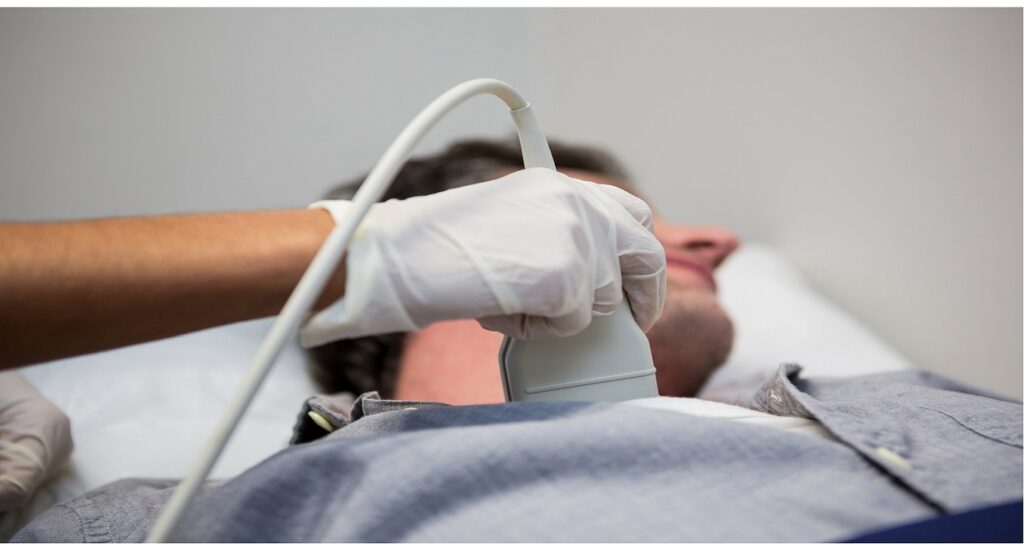The use of Home Carotid Doppler is a benign medical diagnostic that aids doctors in the diagnosis and treatment of medical disorders.
It is risk-free and painless. It creates images of the inner workings of the body by using sound waves. Sonography is another name for ultrasound imaging. It employs a small probe known as a transducer and hydrogel applied directly to the skin.
The search collects the noises that bounce back. Ultrasonic tests do not involve the use of radioactivity (x-rays). Because ultrasound images are captured in real-time, they can reveal the framework and circulation of the body within. In the photographs, blood may also be seen streaming through arteries in the body.
An ultrasonic scan of the body’s major carotid arteries on either side of the cervical spine carrying blood from the center to the brain’s activity provides detailed images and data on the blood passing through them.
A carotid ultrasound usually includes a Home Carotid Doppler. Doppler ultrasonography is a type of ultrasound that measures the shifting of substances in the body. It allows the clinician to see and assess blood flow through the body’s arteries and veins.
What are some of the procedure’s most common applications?
Carotid ultrasonography is most commonly used for identifying reducing or narrowing of the artery, significantly raising the risk of strokes.
The primary purpose of cerebral ultrasound is to check patients for carotid artery blockage or narrowing, which, if present, may increase the patient’s risk of stroke. A complete treatment may be undertaken if a considerable constriction is identified.
It may also be done if an individual develops high blood pressure and a cerebral bruit, a distinctive sound in the neck that may be heard with a stethoscope. It is also used in rare circumstances to prepare for bypass surgery for coronary artery disease. Other hazards necessitate a carotid ultrasound.
Diabetes causes an increase in blood cholesterol.
Having a stroke or coronary artery disease in the family.
An ultrasound of the carotid arteries is additionally carried out to:
Find a hematoma, a clump of clotted blood that can delay or stop blood flow.
Check the carotid vein after surgery to ensure proper blood flow.
Check the orientation of the metal stent used to keep the carotid blood flow going.
Doppler ultrasound enables the clinician to observe and assess:
Obstructing the flow of blood (such as clots)
tumors and congenital vascular anomalies, constriction of veins, reduced or absent blood supply to various organs such as the testes or ovaries increased circulation, which may be an indication of infection
Doppler ultrasonography is used in children to:
Analyse blood flow.
Children experiencing sickle cell disease have an increased risk of stroke.
Detect anomalies in blood vessels, lymph nodes, and lymphatic vessels.
What need I do to prepare?
Wear loose-fitting, comfy clothing. Ultrasound tests are extremely dependent on motion, and a busy or crying youngster can cause the test to take longer. It is generally helpful to explain the operation to the youngster ahead so the exam to ensure a seamless encounter. Bring books, tiny toys, music, or activities to keep the child occupied, and the time passes fast. There could be a television in the exam room.
There is no extra preparation needed.
What are the advantages?
Most Home Carotid Doppler scanning is noninvasive (no needles or injections).
An ultrasound examination may sometimes be uncomfortable but should never be painful.
Ultrasound is more widely available, simple to comprehend, and less costly than most other forms of imaging.
Ultrasound imaging is fully risk-free and does not use radioactive.
Tissues with soft tissue that fail to show up nicely on X-ray images are visible with ultrasound scanning.
Suppose a carotid ultrasonography check reveals that either or both arteries are narrowed. In that case, therapy can be initiated to restore the open exchange of oxygen and nutrients to the brain. As a result, many strokes are avoided.
Conclusion
The Majeed Cardiac Care has proven its worth in providing comprehensive, high-quality care to patients with heart disease. It has increased patient access, patient happiness, and outcomes. Home Carotid Doppler has contributed to reducing the financial burden of heart disease by focusing on preventative and early detection. Finally, by offering more effective and affordable care, it has helped to cut healthcare expenses. It is a great asset in the struggle against cardiovascular disease, and its advantages will be felt for many years.

